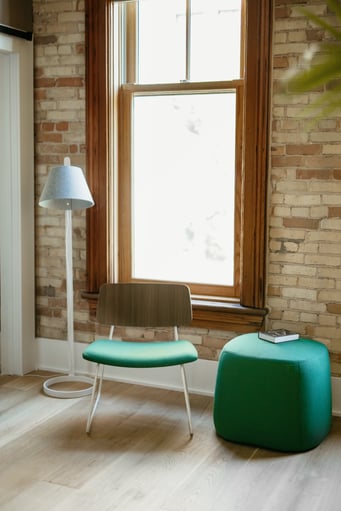As the demand has accelerated for healthy and sustainable spaces, there’s a new understanding of how interior designers can make a positive impact in the world through their work.
Interior designers have opportunities to address climate, health, and equity issues, said Avinash Rajagopal, Metropolis Magazine Editor-in-Chief and author of Hacking Design. An in-demand speaker throughout the global design world, Avinash joined Haworth to discuss a new industry-wide framework for practicing sustainable design. Haworth offers many sustainable solutions with their competitively solicited and publicly awarded contract through OMNIA Partners.
Currently, the building sector contributes to greenhouse gas emissions and the climate crisis. The industry produces about 39% of the world's carbon dioxide emissions, the standard used to measure global warming.

Shift toward Embodied Carbon
About 75% of the industry’s emissions come from operational carbon, which is the energy consumed to operate buildings—from keeping the lights on to running air conditioning systems. The rest is embodied carbon, attributed to building materials and construction.
Embodied carbon is the “energy we use to pull materials out of the earth, turn them into products, bring those products to building sites, and turn them into buildings or interiors,” Avinash explained. It also includes the energy used to remove those products to make way for renovation or new construction, and to dispose of those products—whether they go into the landfill or are recycled or reused.
There is a push globally to convert the energy infrastructure to renewable energy. Between now and 2050, the industry’s current ratio of 72% operational carbon and 28% embodied carbon is going to shift closer to 50/50. Embodied carbon is going to become a bigger share of the world’s carbon emissions, as operational carbon is reduced.
New Focus on Renovation Emissions
Renovations are an elemental part of design work, and embodied carbon emissions are created through them. Interior renovations include furniture, lighting, flooring, walls, ceilings, and everything else that makes up the inside of a building.
“If you're in hospitality, you're usually looking to change out the interiors of your properties about every five years,” Avinash said. “If you're in healthcare, a facilities manager usually is tasked with keeping finishes and furnishings up to date, changing those out every 10 years."
Workplace leases are also getting shorter and shorter. “So, every time a tenant leaves a building, or a new tenant moves into that space, the interiors get turned," Avinash explained. "Even companies who own their spaces are refreshing them every five years—sometimes in tech companies, every three years.”
Over the life of a building, interior renovations actually end up being as consequential or more consequential than concrete, steel, glass, and all the building materials that have traditionally been viewed as an environmental problem.
Responding to Clients' Sustainable Design Concerns
“Clients who are funding our projects are beginning to care,” Avinash said, noting a rising number of corporations introducing net-zero goals. Many are pledging to completely negate their carbon emissions by 2030, 2040, or 2050, so sustainable design is important to them. Clients want to know where the office furniture they are buying is coming from, for example, and what emissions are associated with it.
“Leaders in our industry are beginning to ask questions about their supply chains and their real estate,” Avinash said.
Because most of the design industry’s emissions are tied to embodied carbon, how products and materials are selected for projects is absolutely vital. That’s why it’s essential to learn to reduce, reuse, and recycle for sustainable design.
“Luckily, the manufacturers in our industry, like Haworth and others, have done amazing work already in looking at their supply chains and providing transparency information,” Avinash said. “The information is out there for us to use—to know how we can do better with our work as interior designers.”
Haworth’s Sustainability Commitment
At Haworth, we think beyond our business with a collective purpose to make the world better. We are committed to designing products with people in mind while making the best use of the Earth’s resources for a sustainable future. This means supporting a circular economy and making material choices that keep our resources in closed loops—by recycling, reusing, and rethinking our processes.
In the US alone, 55 million pounds of synthetic plastic textiles are sent to landfills every day. Only 1% of all synthetic and plastic-based textiles are eventually fully recycled. Haworth offers textiles that have been redesigned from thrown-away materials into revolutionary sustainable textiles. Learn more about a few of the environment-friendly textiles from Haworth by clicking the images below:
Scapes
|
Hobson
|
Oceanic
|
About OMNIA Partners & Haworth
Haworth is dedicated to providing a range of products and services for your workspace to increase efficiency. Participants can access Haworth's extensive portfolio and save time and money on your next workspace vision by utilizing the OMNIA Partners cooperative contract. Haworth is your partner in transforming space, no matter where you're located. Ready to get started? Discover the entire OMNIA Partners cooperative contract portfolio today for all your procurement needs.
- TAGS:
- K-12 Education
- , Higher Education
- , Government


